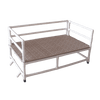Rest Without Strain: Real Tips for Better Sleep with Back Pain

By Lydia Chan
Getting a good night of rest when you're struggling with back pain can feel like an impossible task. The discomfort doesn't magically fade when the lights go out, and often it can feel worse when you're trying to stay still. But there are ways to make bedtime more bearable and to create an environment that allows your body to recover. If back pain has been turning your nights into a battle, it's time to look at some down-to-earth changes that can help.
Find the Right Sleeping Position
Not all sleeping positions are created equal, especially when your back is already irritated. If you're a stomach sleeper, that's usually the worst position since it places your spine in an unnatural curve. Lying on your back with a pillow under your knees can help support the natural curve of your spine, reducing tension in your lower back. Side sleepers often find relief with a pillow between their knees, helping to keep their hips aligned and their lower back supported.
Invest in a Mattress That Supports You
The surface you sleep on matters more than most people realize when it comes to chronic back pain. A mattress that's too soft won't support your spine, and one that's too firm can create pressure points that make pain worse. Foam mattresses with a gliding layer help your body move slightly during sleep while maintaining spinal alignment. Bariatric foam mattresses are designed with extra support in mind and can help with weight distribution, which may be especially beneficial for heavier individuals. Innerspring mattresses remain a solid choice for those who need firmer support without sacrificing a little give.
Look Into Shockwave Therapy as an Option
If you’ve tried everything and your back pain still refuses to ease, it might be worth asking your doctor if extracorporeal shockwave therapy could help. Often used for bone healing and tendon injuries, this non-invasive treatment has shown promise for chronic back pain. Utilizing a shockwave therapy machine, high-energy sound waves are delivered to the affected area, which may help reduce inflammation and stimulate healing. In a recent survey of SoftWave providers, it was reported the ESWT received via SoftWave Tissue Regenerative Technology was found to be an effective treatment for 88.3% of patients with chronic symptoms.
Use Relaxation Techniques to Unwind
When your body is tense from pain, your mind often follows suit, which can keep you locked in a state of stress as you try to fall asleep. Practicing relaxation techniques like deep breathing, progressive muscle relaxation, or even listening to calming music can settle your nervous system. Creating a wind-down routine signals your body that it's time to let go, not brace for more discomfort. Even a few minutes of deep breathing before bed can help shift your focus away from pain and toward rest.
Stretch it Out Before You Sleep
A gentle stretch can do wonders for muscles that have been locked in tension all day. You don't need to commit to a full yoga session, but a few minutes of basic poses like child's pose, cat-cow, or supine twists can help loosen up your back and get your blood flowing. Moving slowly and deliberately lets your muscles unwind so they aren't stiff and inflamed when you lie down. Over time, adding stretching to your nightly routine may also improve your flexibility and decrease pain levels.
Make Your Room a Place for Sleep
Back pain might be the loudest obstacle, but your sleep environment could be making things worse. A cluttered, noisy, or poorly lit room keeps your brain alert instead of allowing it to settle into rest mode. Try blackout curtains, white noise machines, and keeping screens out of the bedroom to create a calm, distraction-free space. Keeping the room cool can also help you sleep better since your body naturally drops in temperature as you drift off.
Your Sleep Hygiene Still Matters
Even when you're dealing with a legitimate physical issue like back pain, the basics of good sleep hygiene still count. Going to bed and waking up at the same time each day, avoiding naps that throw off your rhythm, and limiting screen time in the evening all play a role. When you stack these habits with pain-reducing strategies, they can create a stable framework for better sleep. Pain might not vanish overnight, but your ability to manage it improves with consistency.
Back pain doesn't have to keep you up all night if you approach sleep from a few different angles. Small adjustments to your habits, your bedroom, and your mattress can open the door to better rest and less pain. No one solution will work for everyone, but the goal is to create a setup where your body feels safe enough to relax. Sleep is when your body heals, and giving yourself that chance can shift everything from how you feel in the morning to how well you function throughout the day.
Discover reliable and affordable medical equipment solutions at Dansons Medical, where your family’s health and comfort are our top priority!
- Dansons Medical Support


 Lifts
Lifts
 Patient Lifts
Patient Lifts
 Stand Assists
Stand Assists
 Standing Aids
Standing Aids
 Slings
Slings
 Parts & Accessories
Parts & Accessories
 Wheelchairs
Wheelchairs
 Ergonomic
Ergonomic
 Portable
Portable
 Reclining
Reclining
 Standing
Standing
 Sporting
Sporting
 Bariatric
Bariatric
 Ramps
Ramps
 Modular
Modular
 Portable
Portable
 Parts & Accessories
Parts & Accessories
 Walking Aids
Walking Aids
 Rollator Walkers
Rollator Walkers
 Canes
Canes
 Crutches
Crutches
 Parts & Accessories
Parts & Accessories
 Scooters
Scooters
 4-Wheel
4-Wheel
 Folding
Folding
 Parts & Accessories
Parts & Accessories
 Nursing
Nursing
 Pregnancy Comfort
Pregnancy Comfort
 Self-Care
Self-Care
 Pump Parts
Pump Parts
 Exercise Equipment
Exercise Equipment
 Treadmills
Treadmills
 Walking Pads
Walking Pads
 Rowing Machines
Rowing Machines
 Strength & Conditioning
Strength & Conditioning
 Massage Chairs
Massage Chairs
 Saunas
Saunas
 Hot & Cold Tubs
Hot & Cold Tubs
 Stethoscopes
Stethoscopes
 Surgical Instruments
Surgical Instruments
 Forceps
Forceps
 Scalpels
Scalpels
 IV Poles
IV Poles
 Oxygen
Oxygen
 Beds
Beds
 Electric Beds
Electric Beds
 Standing Beds
Standing Beds
 Mattresses
Mattresses
 Bed Accessories
Bed Accessories
 Bed Parts
Bed Parts
 Chairs
Chairs
 Medical Recliners
Medical Recliners
 Phlebotomy Chairs
Phlebotomy Chairs
 Stools & Task Chairs
Stools & Task Chairs
 Parts & Accessories
Parts & Accessories
 Tables
Tables
 Overbed Tables
Overbed Tables
 Medical Tables
Medical Tables
 Recovery Couches
Recovery Couches
 Cabinets
Cabinets
 Pool
Pool
 Pool Lifts
Pool Lifts
 Pool Fitness & Therapy
Pool Fitness & Therapy
 Pool Access Chairs
Pool Access Chairs
 Slings
Slings
 Parts & Accessories
Parts & Accessories
 Bath
Bath
 Toileting Aids
Toileting Aids
 Bath Lifts
Bath Lifts
 Shower Seats
Shower Seats
 Parts & Accessories
Parts & Accessories
 Portable Shower
Portable Shower
 Dansons Products
Dansons Products
 Transfer Aids
Transfer Aids
 Cushions
Cushions
 eBooks
eBooks
 Helpful Articles
Helpful Articles
 Reviews
Reviews
 Contact Us
Contact Us
 Create Account
Create Account
 Request a Quote
Request a Quote

Comments 0